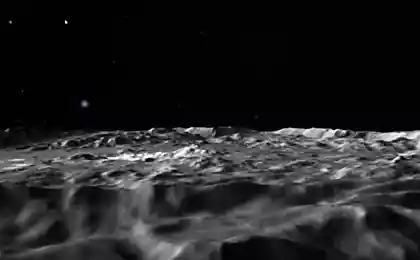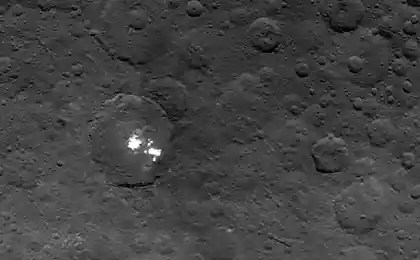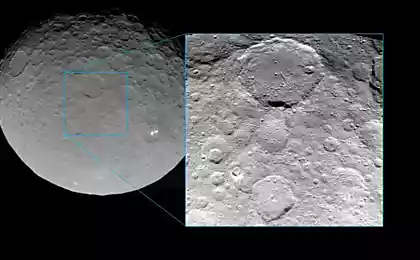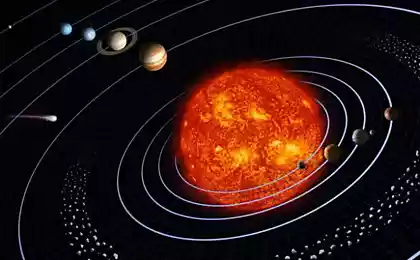777
Dawn probe has sent detailed pictures of craters Ceres
93,906,526
Crater Kupalo, one of the youngest craters on Ceres. Photo: NASA / JPL-Caltech / UCLA / MPS / DLR / IDA (when you click on the image to open the picture in full size) i>
Spacecraft that far from the Earth working for the benefit of science, continue to transmit valuable data. Particularly interesting pictures of other worlds. Recently, photos were published by Pluto in high definition, and now the probe Dawn has sent no less than high-quality images of Ceres. These photographs were obtained at a distance of 385 kilometers from planetoid in the period between 19 and 23 December 2015 year.
Resolution of images is 35 meters per pixel. This was taken as a crater Kupalo, one of the youngest craters on the planetoid. Here the plot is seen, it's probably salt. Also crater flat bottom formed, probably rocks melt at Ceres collision with some object and debris. Experts gather to explore the pictures, perhaps they will be able to compare the structure and composition of the crater and Kupalo Occator.
32,797,411
Crater Messor. Photo: NASA / JPL-Caltech / UCLA / MPS / DLR / IDA (when you click on the image to open the picture in full size) i>
"The crater and the newly formed deposits will be the main goal for the team to study the project», сообщил one of the project participants.
In the crater Dantu scientists have discovered an interesting network of fractures, the width of the crater is 126 kilometers. It is interesting that in the crater Tycho, that on the moon, scientists have found a similar network of cracks.
92,503,707
Crater Dantu. Photo NASA / JPL-Caltech / UCLA / MPS / DLR / IDA (when you click on the image to open the picture in full size) i>
In mid-December last year, almost all the tools of the probe has focused on the Ceres. Plain and infrared spectrometer to study the reflection of light in the visible spectrum of different wavelengths from the surface of the planetoid.
The unit will be located at the current position to the end of its primary mission (June 30, 2016).
18,251,462
One of the craters Ceres (23 December 2013). Photo - NASA / JPL-Caltech / UCLA / MPS / DLR / IDA (when you click on the image to open the picture in full size) i>
Source: geektimes.ru/post/269096/
Crater Kupalo, one of the youngest craters on Ceres. Photo: NASA / JPL-Caltech / UCLA / MPS / DLR / IDA (when you click on the image to open the picture in full size) i>
Spacecraft that far from the Earth working for the benefit of science, continue to transmit valuable data. Particularly interesting pictures of other worlds. Recently, photos were published by Pluto in high definition, and now the probe Dawn has sent no less than high-quality images of Ceres. These photographs were obtained at a distance of 385 kilometers from planetoid in the period between 19 and 23 December 2015 year.
Resolution of images is 35 meters per pixel. This was taken as a crater Kupalo, one of the youngest craters on the planetoid. Here the plot is seen, it's probably salt. Also crater flat bottom formed, probably rocks melt at Ceres collision with some object and debris. Experts gather to explore the pictures, perhaps they will be able to compare the structure and composition of the crater and Kupalo Occator.
32,797,411
Crater Messor. Photo: NASA / JPL-Caltech / UCLA / MPS / DLR / IDA (when you click on the image to open the picture in full size) i>
"The crater and the newly formed deposits will be the main goal for the team to study the project», сообщил one of the project participants.
In the crater Dantu scientists have discovered an interesting network of fractures, the width of the crater is 126 kilometers. It is interesting that in the crater Tycho, that on the moon, scientists have found a similar network of cracks.
92,503,707
Crater Dantu. Photo NASA / JPL-Caltech / UCLA / MPS / DLR / IDA (when you click on the image to open the picture in full size) i>
In mid-December last year, almost all the tools of the probe has focused on the Ceres. Plain and infrared spectrometer to study the reflection of light in the visible spectrum of different wavelengths from the surface of the planetoid.
The unit will be located at the current position to the end of its primary mission (June 30, 2016).
18,251,462
One of the craters Ceres (23 December 2013). Photo - NASA / JPL-Caltech / UCLA / MPS / DLR / IDA (when you click on the image to open the picture in full size) i>
Source: geektimes.ru/post/269096/
Chinese manufactured material for efficiently converting carbon dioxide into fuel
Scientists have invented new ways of cutting pizza























